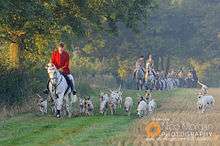Cottesmore Hunt
|
Brass at Cottesmore with the Cottesmore Hounds, by John Ferneley, 1818 | |
| Hunt type | Foxhunt |
|---|---|
| Country |
|
| History | |
| Founded | 1666 |
| Hunt information | |
| Hound breed | Foxhound |
| Hunt country | Leicestershire, Rutland & Lincolnshire |
| Master(s) |
Jenny Dale MFH, Bee Bell MFH, Nicholas Leeming MFH, Andrew Osborne MFH, Gemma McCormick MFH & Ashley Bealby MFH. |
| Whipper(s)-in | Robert Medcalf |
| Quarry | Fox |
| Kennelled | Ashwell, Rutland |
| Website | www.cottesmore-hunt.co.uk/ |

The Cottesmore Hunt, which hunts mostly in Rutland, is one of the oldest foxhound packs in Britain. Its name comes from the village of Cottesmore where the hounds were kennelled.
History

The Cottesmore Hunt's origins may be traced back to 1666 when Viscount Lowther made the long journey by a road with his own pack of foxhounds from Lowther Castle in Westmorland to Fineshade Abbey in East Northamptonshire. The Lowther family sold their pack to the Earl of Gainsborough.
From 1696 to 1779 there had been a joint arrangement between John Manners, 3rd Duke of Rutland, Master of the Belvoir, and the Earl of Gainsborough, Earl Cardigan, Lord Howe and Lord Gower, to hunt one pack on a shared basis in the huge area from Belvoir southwards into East Northamptonshire. Hounds were moved between three different kennels, including Cottesmore, each season. The Gainsborough family withdrew from this joint Hunt in 1732 and took 25 couple of hounds that began to hunt the country later known as the Cottesmore.
In 1776 Tom Noel made an agreement with Hugo Meynell, first Master of the Quorn, known as the "Father of Foxhunting". They agreed on boundaries between the Quorn and the Gainsborough pack, kennelled at Cottesmore, that enabled both packs to draw numerous coverts, including those at Owston, Launde and Tilton, nowadays well inside the Cottesmore country.
Sir William Lowther bought the pack from the Gainsboroughs and hunted the Cottesmore country from 1788 until 1802 when he became Viscount Lowther. At first he rented Stocken Hall, but later rented Cottesmore House where he kennelled the hounds, and from which the pack derived its permanent name.
Lowther made the Cottesmore Hunt more widely popular. "Earl William" and his staff wore hairy flat-topped hats, and it is believed R. S. Surtees depicted them as "The Flat Hat Hunt", with Lord Scamperdale as Master, in Mr Sponge's Sporting Tour.
The Cottesmore pack was purchased from the new Viscount Lowther in 1802 by Sir Gilbert Heathcote, 4th Baronet of Normanton Park. He employed the celebrated horse-breaker Dick Christian as whipper-in. However, after only four years, William Lowther, the new Earl Lonsdale resumed his Mastership, and continuing in office for another 36 years. Sir Henry Sutton, Henley Greaves and Sir John Trollope provided a series of shorter Masterships up to 1870 when the Lowthers returned again.
During this time a large part of the country up to Whissendine was loaned to Mr Tailby of Skeffington who, with his own pack, hunted much of the country that later became the Fernie.
Col. Henry Lowther, second son of the second Earl Lonsdale, became Master in 1870. Henry Lowther bought hounds from Tailby for £1,300. Henry lived at Asfordby before moving to Barleythorpe Hall, near Oakham, which his father purchased for him as a hunting box. Henry, who became 3rd Earl Lonsdale, built lavish kennels and stables at Barleythorpe from 1872.
New kennels and stables were built at Langham, completed in 1889. The buildings were intended to accommodate 100 couple of hounds, 50 horses, and housed most of the Hunt staff of some 40 grooms and kennelmen. The hunt's kennels moved to premises in Ashwell parish in 2004 when the former kennels were developed for housing, called Kimball Close after Marcus Kimball, Baron Kimball, former MFH.
Three Hunt-class warships of the Royal Navy have been named HMS Cottesmore after the hunt.
Country
The Cottesmore country extends 18 miles north to south and 22 miles east to west and lies mostly in Rutland, together with some smaller areas of Leicestershire and Lincolnshire. Its country converges with that of its neighbours the Quorn and the Belvoir (Duke of Rutland’s) in Melton Mowbray which in its heyday was a magnet for foxhunters worldwide and now has the UK's only foxhunting museum.
After the Hunting Act
Although "hunting wild mammals with a dog" was made unlawful in England and Wales by the Hunting Act 2004, which came into effect in 2005,[1] a number of exemptions stated in Schedule 1 of the 2004 Act permit some previously unusual forms of hunting wild mammals with dogs to continue, such as "hunting... for the purpose of enabling a bird of prey to hunt the wild mammal".[2] The Cottesmore continues to operate within the law, using a combination of laid trails and flushing the fox to a bird of prey, a golden eagle.[3]
See also
References
- ↑ Hunting Act 2004 Archived 7 April 2009 at the Wayback Machine., text online at opsi.gov.uk
- ↑ Stephen Moss, The banned rode on: Eighteen months ago hunting was banned. Or was it? from The Guardian dated 7 November 2006, at guardian.co.uk, accessed 29 April 2013
- ↑ Home page at cottesmore-hunt.co.uk/
External links
- cottesmore-hunt.co.uk - official web site
- THE CASE FOR THE COTTESMORE HUNT By James Barclay, Joint Master, February 17, 2000
